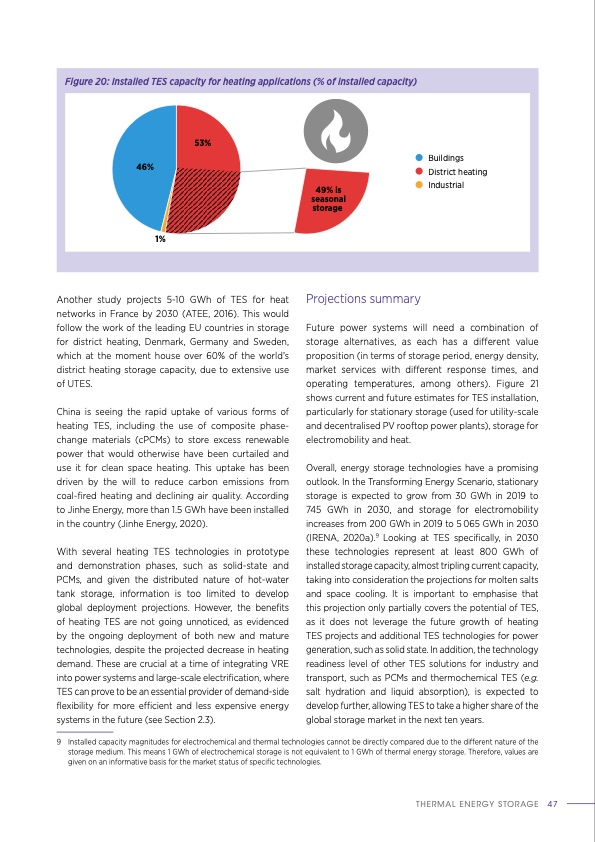
PDF Publication Title:
Text from PDF Page: 047
Figure 20: Installed TES capacity for heating applications (% of installed capacity) 53% 46% 1% 49% is seasonal storage Buildings District heating Industrial Another study projects 5-10 GWh of TES for heat networks in France by 2030 (ATEE, 2016). This would follow the work of the leading EU countries in storage for district heating, Denmark, Germany and Sweden, which at the moment house over 60% of the world’s district heating storage capacity, due to extensive use of UTES. China is seeing the rapid uptake of various forms of heating TES, including the use of composite phase- change materials (cPCMs) to store excess renewable power that would otherwise have been curtailed and use it for clean space heating. This uptake has been driven by the will to reduce carbon emissions from coal-fired heating and declining air quality. According to Jinhe Energy, more than 1.5 GWh have been installed in the country (Jinhe Energy, 2020). With several heating TES technologies in prototype and demonstration phases, such as solid-state and PCMs, and given the distributed nature of hot-water tank storage, information is too limited to develop global deployment projections. However, the benefits of heating TES are not going unnoticed, as evidenced by the ongoing deployment of both new and mature technologies, despite the projected decrease in heating demand. These are crucial at a time of integrating VRE into power systems and large-scale electrification, where TES can prove to be an essential provider of demand-side flexibility for more efficient and less expensive energy systems in the future (see Section 2.3). Projections summary Future power systems will need a combination of storage alternatives, as each has a different value proposition (in terms of storage period, energy density, market services with different response times, and operating temperatures, among others). Figure 21 shows current and future estimates for TES installation, particularly for stationary storage (used for utility-scale and decentralised PV rooftop power plants), storage for electromobility and heat. Overall, energy storage technologies have a promising outlook. In the Transforming Energy Scenario, stationary storage is expected to grow from 30 GWh in 2019 to 745 GWh in 2030, and storage for electromobility increases from 200 GWh in 2019 to 5 065 GWh in 2030 (IRENA, 2020a).9 Looking at TES specifically, in 2030 these technologies represent at least 800 GWh of installed storage capacity, almost tripling current capacity, taking into consideration the projections for molten salts and space cooling. It is important to emphasise that this projection only partially covers the potential of TES, as it does not leverage the future growth of heating TES projects and additional TES technologies for power generation, such as solid state. In addition, the technology readiness level of other TES solutions for industry and transport, such as PCMs and thermochemical TES (e.g. salt hydration and liquid absorption), is expected to develop further, allowing TES to take a higher share of the global storage market in the next ten years. 9 Installed capacity magnitudes for electrochemical and thermal technologies cannot be directly compared due to the different nature of the storage medium. This means 1 GWh of electrochemical storage is not equivalent to 1 GWh of thermal energy storage. Therefore, values are given on an informative basis for the market status of specific technologies. THERMAL ENERGY STORAGE 47PDF Image | THERMAL ENERGY STORAGE Outlook

PDF Search Title:
THERMAL ENERGY STORAGE OutlookOriginal File Name Searched:
IRENA_Innovation_Outlook_TES_2020.pdfDIY PDF Search: Google It | Yahoo | Bing
Turbine and System Plans CAD CAM: Special for this month, any plans are $10,000 for complete Cad/Cam blueprints. License is for one build. Try before you buy a production license. More Info
Waste Heat Power Technology: Organic Rankine Cycle uses waste heat to make electricity, shaft horsepower and cooling. More Info
All Turbine and System Products: Infinity Turbine ORD systems, turbine generator sets, build plans and more to use your waste heat from 30C to 100C. More Info
CO2 Phase Change Demonstrator: CO2 goes supercritical at 30 C. This is a experimental platform which you can use to demonstrate phase change with low heat. Includes integration area for small CO2 turbine, static generator, and more. This can also be used for a GTL Gas to Liquids experimental platform. More Info
Introducing the Infinity Turbine Products Infinity Turbine develops and builds systems for making power from waste heat. It also is working on innovative strategies for storing, making, and deploying energy. More Info
Need Strategy? Use our Consulting and analyst services Infinity Turbine LLC is pleased to announce its consulting and analyst services. We have worked in the renewable energy industry as a researcher, developing sales and markets, along with may inventions and innovations. More Info
Made in USA with Global Energy Millennial Web Engine These pages were made with the Global Energy Web PDF Engine using Filemaker (Claris) software.
Sand Battery Sand and Paraffin for TES Thermo Energy Storage More Info
| CONTACT TEL: 608-238-6001 Email: greg@infinityturbine.com | RSS | AMP |